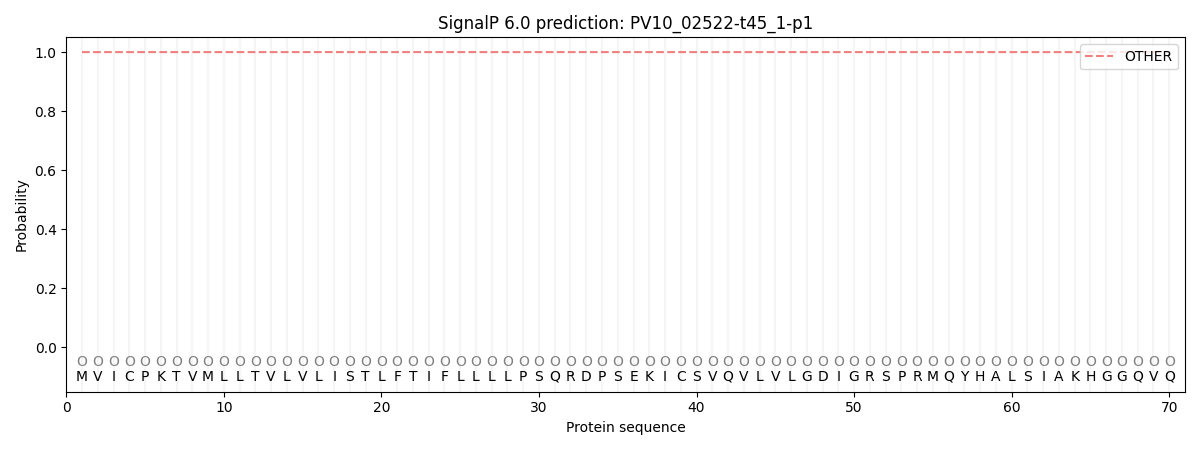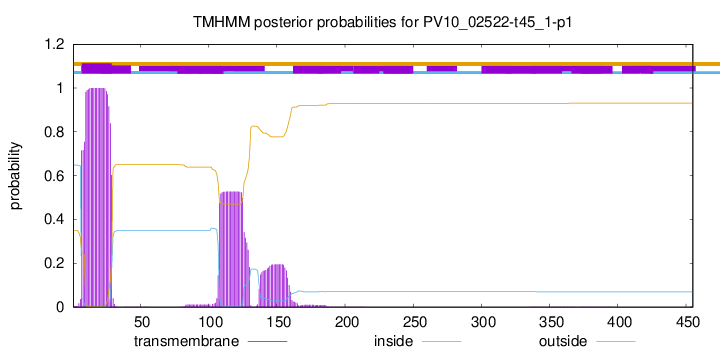You are browsing environment: FUNGIDB
CAZyme Information: PV10_02522-t45_1-p1
You are here: Home > Sequence: PV10_02522-t45_1-p1
Basic Information |
Genomic context |
Full Sequence |
Enzyme annotations |
CAZy signature domains |
CDD domains |
CAZyme hits |
PDB hits |
Swiss-Prot hits |
SignalP and Lipop annotations |
TMHMM annotations
Basic Information help
| Species | Exophiala mesophila | |||||||||||
|---|---|---|---|---|---|---|---|---|---|---|---|---|
| Lineage | Ascomycota; Eurotiomycetes; ; Herpotrichiellaceae; Exophiala; Exophiala mesophila | |||||||||||
| CAZyme ID | PV10_02522-t45_1-p1 | |||||||||||
| CAZy Family | CBM21 | |||||||||||
| CAZyme Description | hypothetical protein | |||||||||||
| CAZyme Property |
|
|||||||||||
| Genome Property |
|
|||||||||||
| Gene Location | Start: 1888659; End:1890131 Strand: + | |||||||||||
Full Sequence Download help
| MVICPKTVML LTVLVLISTL FTIFLLLLPS QRDPSEKICS VQVLVLGDIG RSPRMQYHAL | 60 |
| SIAKHGGQVQ LIGYLESEPL PELLAHPGAT IIPLTPSPRV LQTSNRTLFL LYAPLKVLLQ | 120 |
| LWFLWRALGY TSKPAKWLLV QNPPSIPTLL IASLISIARG TRLIIDWHNF GYSILALKLG | 180 |
| ARHPLVSLSK TYETFFAKAA TANFAVTDAM AKIIKADFVT QSPVLTLHDR PAEIYRPLTQ | 240 |
| AQRAAFLENY SLLASHFKSI LDNKARLLVS STSWTADEDF GLFLDALSAY SASSTSLRTH | 300 |
| LPELVVVITG KGPQKDFYLD RIRHLNASNA LKRVTIYTDW LSFDNYALLL GSADLGISLH | 360 |
| TSSSGVDLPM KVVDMFGAGL PVLGWSKFAA WPELVQEDVN GRGFESSDEM AEHLRQLCDP | 420 |
| SSTQLARLKQ GAQLESRRRW SSEWDAVAGK LLGFT | 455 |
Enzyme Prediction help
| EC | 2.4.1.142:10 | 2.4.1.-:1 |
|---|
CAZyme Signature Domains help
| Family | Start | End | Evalue | family coverage |
|---|---|---|---|---|
| GT33 | 40 | 450 | 1.8e-147 | 0.9905882352941177 |
CDD Domains download full data without filtering help
| Cdd ID | Domain | E-Value | qStart | qEnd | sStart | sEnd | Domain Description |
|---|---|---|---|---|---|---|---|
| 340843 | GT33_ALG1-like | 0.0 | 40 | 452 | 5 | 411 | chitobiosyldiphosphodolichol beta-mannosyltransferase and similar proteins. This family is most closely related to the GT33 family of glycosyltransferases. The yeast gene ALG1 has been shown to function as a mannosyltransferase that catalyzes the formation of dolichol pyrophosphate (Dol-PP)-GlcNAc2Man from GDP-Man and Dol-PP-Glc-NAc2, and participates in the formation of the lipid-linked precursor oligosaccharide for N-glycosylation. In humans ALG1 has been associated with the congenital disorders of glycosylation (CDG) designated as subtype CDG-Ik. |
| 215155 | PLN02275 | 2.62e-136 | 41 | 417 | 7 | 370 | transferase, transferring glycosyl groups |
| 340831 | GT4_PimA-like | 5.68e-13 | 82 | 454 | 25 | 364 | phosphatidyl-myo-inositol mannosyltransferase. This family is most closely related to the GT4 family of glycosyltransferases and named after PimA in Propionibacterium freudenreichii, which is involved in the biosynthesis of phosphatidyl-myo-inositol mannosides (PIM) which are early precursors in the biosynthesis of lipomannans (LM) and lipoarabinomannans (LAM), and catalyzes the addition of a mannosyl residue from GDP-D-mannose (GDP-Man) to the position 2 of the carrier lipid phosphatidyl-myo-inositol (PI) to generate a phosphatidyl-myo-inositol bearing an alpha-1,2-linked mannose residue (PIM1). Glycosyltransferases catalyze the transfer of sugar moieties from activated donor molecules to specific acceptor molecules, forming glycosidic bonds. The acceptor molecule can be a lipid, a protein, a heterocyclic compound, or another carbohydrate residue. This group of glycosyltransferases is most closely related to the previously defined glycosyltransferase family 1 (GT1). The members of this family may transfer UDP, ADP, GDP, or CMP linked sugars. The diverse enzymatic activities among members of this family reflect a wide range of biological functions. The protein structure available for this family has the GTB topology, one of the two protein topologies observed for nucleotide-sugar-dependent glycosyltransferases. GTB proteins have distinct N- and C- terminal domains each containing a typical Rossmann fold. The two domains have high structural homology despite minimal sequence homology. The large cleft that separates the two domains includes the catalytic center and permits a high degree of flexibility. The members of this family are found mainly in certain bacteria and archaea. |
| 340825 | GT4_WbuB-like | 1.07e-08 | 37 | 452 | 1 | 391 | Escherichia coli WbuB and similar proteins. This family is most closely related to the GT1 family of glycosyltransferases. WbuB in E. coli is involved in the biosynthesis of the O26 O-antigen. It has been proposed to function as an N-acetyl-L-fucosamine (L-FucNAc) transferase. |
| 340816 | Glycosyltransferase_GTB-type | 1.62e-06 | 202 | 404 | 60 | 235 | glycosyltransferase family 1 and related proteins with GTB topology. Glycosyltransferases catalyze the transfer of sugar moieties from activated donor molecules to specific acceptor molecules, forming glycosidic bonds. The acceptor molecule can be a lipid, a protein, a heterocyclic compound, or another carbohydrate residue. The structures of the formed glycoconjugates are extremely diverse, reflecting a wide range of biological functions. The members of this family share a common GTB topology, one of the two protein topologies observed for nucleotide-sugar-dependent glycosyltransferases. GTB proteins have distinct N- and C- terminal domains each containing a typical Rossmann fold. The two domains have high structural homology despite minimal sequence homology. The large cleft that separates the two domains includes the catalytic center and permits a high degree of flexibility. |
CAZyme Hits help
| Hit ID | E-Value | Query Start | Query End | Hit Start | Hit End |
|---|---|---|---|---|---|
| CAP97332.1|GT33 | 4.10e-174 | 17 | 455 | 12 | 462 |
| QRC90248.1|GT33 | 1.58e-173 | 11 | 451 | 19 | 487 |
| EAA62506.1|GT33 | 2.12e-171 | 17 | 453 | 12 | 459 |
| QKX64524.1|GT33 | 6.73e-170 | 18 | 453 | 13 | 457 |
| BCS17327.1|GT33 | 3.73e-169 | 17 | 453 | 12 | 457 |
Swiss-Prot Hits download full data without filtering help
| Hit ID | E-Value | Query Start | Query End | Hit Start | Hit End | Description |
|---|---|---|---|---|---|---|
| sp|D4AZD1|ALG1_ARTBC | 3.58e-128 | 14 | 453 | 3 | 444 | Chitobiosyldiphosphodolichol beta-mannosyltransferase OS=Arthroderma benhamiae (strain ATCC MYA-4681 / CBS 112371) OX=663331 GN=ARB_01551 PE=3 SV=1 |
| sp|Q6C3K2|ALG1_YARLI | 1.82e-88 | 25 | 451 | 20 | 437 | Chitobiosyldiphosphodolichol beta-mannosyltransferase OS=Yarrowia lipolytica (strain CLIB 122 / E 150) OX=284591 GN=ALG1 PE=3 SV=1 |
| sp|O13933|ALG1_SCHPO | 1.61e-85 | 30 | 447 | 19 | 415 | Chitobiosyldiphosphodolichol beta-mannosyltransferase OS=Schizosaccharomyces pombe (strain 972 / ATCC 24843) OX=284812 GN=alg1 PE=3 SV=2 |
| sp|Q8L7M0|TUN_ARATH | 8.02e-84 | 43 | 452 | 9 | 455 | UDP-glycosyltransferase TURAN OS=Arabidopsis thaliana OX=3702 GN=TUN PE=2 SV=1 |
| sp|Q921Q3|ALG1_MOUSE | 9.07e-84 | 14 | 452 | 8 | 461 | Chitobiosyldiphosphodolichol beta-mannosyltransferase OS=Mus musculus OX=10090 GN=Alg1 PE=1 SV=3 |
SignalP and Lipop Annotations help
This protein is predicted as OTHER

| Other | SP_Sec_SPI | CS Position |
|---|---|---|
| 1.000026 | 0.000002 |

